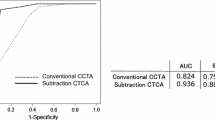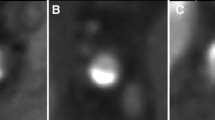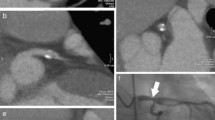Abstract
To investigate the clinical usefulness of subtraction coronary computed tomographic angiography (CCTA) in patients with severe calcification. A 320-row area detector CT system was used in this study. The subjects were 78 patients (47 men and 31 women, 739 years of age) with an Agatston score of >300 who were able to undergo prospective one-beat scanning during a single breath-hold. The CCTA findings were compared against invasive coronary angiography. The diagnostic capabilities of CCTA for the severely calcified segments with and without the additional information provided by subtraction CCTA were compared. Severe calcification was observed in 174 (31.9 %) of the 546 segments, and non-assessable regions were observed in 74 (13.6 %) of the segments. The addition of subtraction CCTA information improved the diagnostic accuracy for segments with severe calcification from 67.8 to 82.8 % on a per-segment basis and from 70.1 to 82.1 % on a per-patient basis, with non-assessable segments considered to be stenotic. When non-assessable segments were considered to be an incorrect diagnosis, the diagnostic accuracy was improved from 48.3 to 75.9 % on a per-segment basis and from 43.3 to 79.1 % on a per-patient basis. In addition, when evaluation was limited to non-assessable segments, subtraction CCTA provided a diagnostic accuracy of 81.1 % when non-assessable segments were considered to be stenotic or 66.2 % when non-assessable segments were considered to be an incorrect diagnosis. Subtraction CCTA improves the diagnostic capabilities of CCTA in patients with severe calcification.


Similar content being viewed by others
References
Bastarrika G, Lee YS, Huda W, Ruzsics B, Costello P, Schoepf UJ (2009) CT of coronary artery disease. Radiology 253:317–338
Dewey M (2011) Coronary CT versus MR angiography: pro CT—the role of CT angiography. Radiology 258:329–339
Taylor AJ, Cerqueira M, Hodgson JM et al (2010) ACCF/SCCT/ACR/AHA/ASE/ASNC/NASCI/SCAI/SCMR 2010 appropriate use criteria for cardiac computed tomography: a report of the American College of Cardiology Foundation Appropriate Use Criteria Task Force, the Society of Cardiovascular Computed Tomography, the American College of Radiology, the American Heart Association, the American Society of Echocardiography, the American Society of Nuclear Cardiology, the North American Society for Cardiovascular Imaging, the Society for Cardiovascular Angiography and Interventions, and the Society for Cardiovascular Magnetic Resonance. J Am Coll Cardiol 56:1864–1894
Hoffmann MH, Shi H, Schmitz BL, Schmid FT, Lieberknecht M, Schulze R et al (2005) Noninvasive coronary angiography with multislice computed tomography. JAMA 293:2471–2478
Palumbo AA, Maffei E, Martini C, Tarantini G, Di Tanna GL, Berti E et al (2009) Coronary calcium score as gatekeeper for 64-slice computed tomography coronary angiography in patients with chest pain: per-segment and per-patient analysis. Eur Radiol 19:2127–2135
Ahn SJ, Kang DK, Sun JS, Yoon MH (2013) Accuracy and predictive value of coronary computed tomography angiography for the detection of obstructive coronary heart disease in patients with an Agatston calcium score above 400. J Comput Assist Tomogr 37(3):387–394
Yoshioka K, Tanaka R, Muranaka K (2012) Subtraction coronary CT angiography for calcified lesions. Cardiol Clin 30:93–102
Tanaka R, Yoshioka K, Muranaka K (2013) Improved evaluation of calcified segments on coronary CT angiography: a feasibility study of coronary calcium subtraction. Int J Cardiovasc Imaging 29:75–81
Vavere AL, Arbab-Zadeh A, Rochitte CE, Dewey M, Niinuma H, Gottlieb I et al (2011) Coronary artery stenosis: accuracy of 64-detector row CT angiography in segments with mild, moderate, or severe calcification—a subanalysis of the CORE-64 trial. Radiology 261:100–108
Amanuma M, Kondo T, Arai T, Morita H, Matsutani H, Sekine T et al (2015) Segmental distribution of calcifications and non-assessable lesions on coronary computed tomographic angiography: evaluation in symptomatic patients. Jpn J Radiol 33:122–130
Mahabadi AA, Achenbach S, Burgstahler C, Dill T, Fischbach R, Knez A et al (2010) Safety, efficacy, and indications of β-adrenergic receptor blockage to reduce heart rate prior to coronary CT angiography. Radiology 257:614–623
Agatston AS, Janowitz WR, Hildner FJ, Zusmer NR, Viamonte M Jr, Detrano R (1990) Quantification of coronary artery calcium using ultrafast computed tomography. J Am Coll Cardiol 15:827–832
Funama Y, Utsunomiya D, Taguchi K, Oda S, Shimonobo T, Yamashita Y (2014) Automatic exposure control at single- and dual-heartbeat CTCA on a 320-MDCT volume scanner: effect of heart rate, exposure phase window setting, and reconstruction algorithm. Phys Med 30:385–390
Chen MY, Steigner ML, Leung SW, Kumamaru KK, Schultz K, Mather RT et al (2013) Simulated 50 % radiation dose reduction in coronary CT angiography using adaptive iterative dose reduction in three-dimensions (AIDR3D). Int J Cardiovasc Imaging 29:1167–1175
Hausleiter J, Mayer T, Hermann F et al (2009) Estimated Radiation dose associated with cardiac CT angiography. JAMA 301:500–507
Razeto M, Matthews J, Masood S, Steel J, Arakita K. Accurate registration of coronary arteries for volumetric CT digital subtraction angiography. ICGIP 2012 Proc SPIE, vol 8768, p 876834-1
Austen WG, Edwards JE, Frye RL, Gensini GG, Gott VL, Griffith LS et al (1975) A reporting system on patients evaluated for coronary artery disease. Report of the Ad Hoc Committee for Grading of Coronary Artery Disease, Council on Cardiovascular Surgery, American Heart Association. Circulation 51:5–40
Schuetz GM, Schlattmann P, Dewey M (2012) Use of 3 × 2 tables with an intention to diagnose approach to assess clinical performance of diagnostic tests: meta-analytical evaluation of coronary CT angiography studies. BMJ 24(345):e6717
Yoshioka K, Tanaka R, Muranaka K, Sasaki T, Ueda T, Chiba T, Takeda K, Sugawara T (2015) Subtraction coronary CT angiography using second-generation 320-detector row CT. Int J Cardiovasc Imaging 31(Suppl 1):51–58
Machida H, Tanaka I, Fukui R, Shen Y, Ishikawa T, Tate E, Ueno E (2015) Current and novel imaging techniques in coronary CT. Radiographics 35:991–1010
Sano T, Matsutani H, Kondo T, Fujimoto S, Takamura K, Sekine T et al (2013) Prrospective electrocardiogram gated coronary 320-row area detector computed tomography angiography using low tube current scanning with full reconstruction. Jpn J Radiat Technol 69:244–250
Earls JP, Berman EL, Urban BA, Curry CA, Lane JL, Jennings RS et al (2008) Prospectively gated transverse coronary CT angiography versus retrospectively gated helical technique: improved image quality and reduced radiation dose. Radiology 246:742–753
Acknowledgments
The authors would like to thank Dr. Kunihiro Yoshioka and Dr. Ryouichi Tanaka of the Department of Radiology at Iwate Medical University for kindly providing the subtraction CCTA software.
Author information
Authors and Affiliations
Corresponding author
Ethics declarations
Conflict of interest
Dr. M. Amanuma, RTs T. Sano, T. Takayanagi, T. Arai, and S. Takase have a contract of research cooperation with The Toshiba Medical Systems Corporation. This investigation was not funded. Drs. K. Arakita and A. Iwasa are employees of Toshiba Medical Systems Corporation. The other authors declare that they have no conflict of interest.
Ethical approval
All procedures performed in studies involving human participants were in accordance with the ethical standards of the institutional and national research committee and with the 1964 Helsinki declaration and its later amendments or comparable ethical standards.
Informed consent
Written informed consent was obtained from all individual participants included in the study.
Rights and permissions
About this article
Cite this article
Amanuma, M., Kondo, T., Sano, T. et al. Subtraction coronary computed tomography in patients with severe calcification. Int J Cardiovasc Imaging 31, 1635–1642 (2015). https://doi.org/10.1007/s10554-015-0746-3
Received:
Accepted:
Published:
Issue Date:
DOI: https://doi.org/10.1007/s10554-015-0746-3




